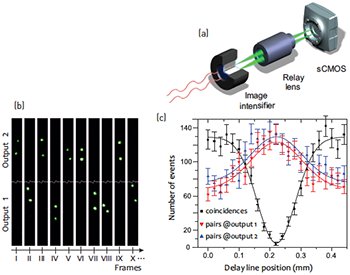 (a) Scheme of the single-photon-sensitive camera system. (b) Direct observation of coalescing photon pairs appearing together in one of the beam-splitter output ports. (c) The Hong-Ou-Mandel dip recovered from camera measurements along with the number of coalesced photon pairs. [M. Jachura and R. Chrapkiewicz. Opt. Lett. 40, 1540 (2015)]
(a) Scheme of the single-photon-sensitive camera system. (b) Direct observation of coalescing photon pairs appearing together in one of the beam-splitter output ports. (c) The Hong-Ou-Mandel dip recovered from camera measurements along with the number of coalesced photon pairs. [M. Jachura and R. Chrapkiewicz. Opt. Lett. 40, 1540 (2015)]
Two indistinguishable photons interfering at a beam splitter will always pair up. This phenomenon, known as Hong-Ou-Mandel effect or two-photon interference, has been one of the most direct manifestations of the quantum nature of light for the past 30 years.1 Physicists harnessed this behavior to demonstrate optical realizations of various quantum-enhanced techniques such as linear quantum computing and ultra-precise interferometry. Researchers have previously used a pair of avalanche photodiodes to detect Hong-Ou-Mandel effect as a sharp drop in coincident photon detections in two beam-splitter output ports while scanning the time-delay between interfering photons. (Data from this demonstration result in a characteristic plot called a Hong-Ou-Mandel dip.) However, for applications like super-resolution imaging, it’s absolutely crucial to know the spatial position—not just the signal detection—of simultaneously detected photons.2
This year, we directly observed spatially resolved Hong-Ou-Mandel two-photon interference.3 For our demonstrations, we assembled a camera system from commercially available elements, including a scientific CMOS (sCMOS) camera endowed with an additional image intensifier based on a microchannel plate—a device often used in night vision technology. We used the system as a matrix of on-off detectors to retrieve, frame by frame, the coordinates of both interfering photons. The photons appeared as bright spots that were easily distinguishable from the low-noise background. Using a real-time software algorithm, we determined the photons’ central positions with subpixel resolution.
The excellent signal-to-noise ratio of our camera system yielded exemplary frames combined with high visibility of the recovered Hong-Ou-Mandel dip. With our new camera system, we extended existing coincidence-imaging schemes where the position of one of the photons used as a trigger is inevitably lost. Moreover, our camera system can be easily employed to detect higher, multiphoton events, providing faithful recovery of the photon number statistics as well as facilitating access to higher-order correlation functions.
We believe that the aforementioned features of our system make intensified cameras one of the most promising solutions for high-resolution single-photon detection. Further technical progress involving the time-stamp functionality and increase in quantum efficiency could make our approach even more powerful—possibly revealing even more fascinating phenomena displayed by non-classical light and bringing quantum-enhanced imaging techniques into the real world.
Researchers
Michał Jachura and Radosław Chrapkiewicz, University of Warsaw, Poland
References
1. C.K. Hong et al. Phys. Rev. Lett. 59, 2044 (1987).
2. M. Tsang. Phys. Rev. Lett. 102, 253601 (2009).
3. M. Jachura and R. Chrapkiewicz. Opt. Lett. 40, 1540 (2015).
